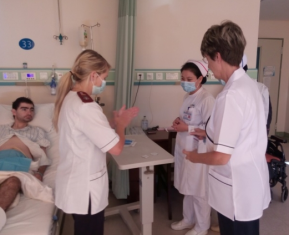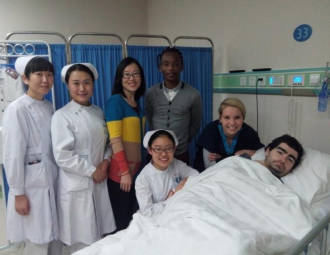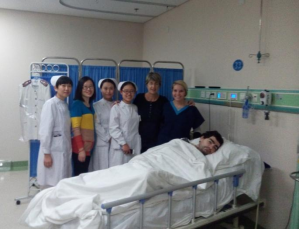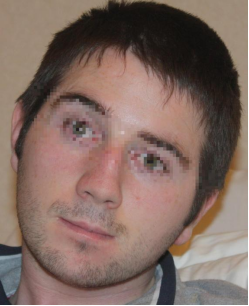
Vaughan was diagnosis of acute lymphoblastic leukemia in June 2012. Patient had done a lot of chemotherapy, while tumors spread from the blood to the spinal cord and then to the brain. Patient came to our hospital for stem cell treatment on Jan 8th, 2015.
Vaughan, a 25-year-old, was diagnosed with acute lymphoblastic leukemia in June 2012. This form of cancer, characterized by the rapid growth of abnormal white blood cells in the bone marrow, immediately set the stage for a challenging battle against the disease.
In an attempt to combat the cancer, Vaughan underwent an extensive series of chemotherapy treatments. Chemotherapy, while a standard and often effective treatment for leukemia, involves the use of powerful drugs to kill cancer cells. However, despite these aggressive efforts, the cancer proved to be tenacious. The tumors, defying the effects of chemotherapy, began to spread. First, they spread from the bloodstream, where the leukemia initially took hold, to the spinal cord, and then unfortunately, advanced further to the brain.
On January 8th, 2015, in search of new hope and treatment options, Vaughan came to our hospital for stem cell treatment. Stem cell therapy holds the potential to replenish the body's supply of healthy blood-forming cells and may offer a new approach to fighting the cancer that has spread so widely.
1. Consciousness and Nutrition
• The patient is in an unconscious state. As a consequence, the only source of sustenance is soft-fluid food, which is delivered directly to the stomach through a feeding tube. This method of nutrition ensures that the patient receives essential nutrients despite their inability to consume food orally.
2. Physical Mobility Limitations
• The patient lacks the ability to sit independently. This not only restricts their daily activities but also has implications for their muscle development and overall physical condition.
• Arm functionality is severely compromised. This limited range of motion also means that they cannot grab objects, further reducing their self -sufficiency.
3. Lack of Expressive and Sensory Abilities
• Facial expressions are completely absent, a clear sign of the patient's inability to convey emotions or respond non-verbally.
• There is a complete absence of sensation in the bottom, legs, and toes. This sensory deprivation can lead to unnoticed injuries and a lack of awareness of the body's position and movement.
4. Sleep Disorder
• The patient suffers from a highly disrupted sleep pattern. Each day, he sleeps for only 1 - 2 hours at a time, followed by 1-2 hours of wakefulness before falling asleep again. This fragmented sleep cycle can have a significant impact on their physical and mental health, as adequate sleep is crucial for the body's recovery and normal functioning.
First Course of Stem Cell Treatment (Jan, 2015)
Outcomes After the First Course of Treatment (1 day)
A remarkable change was reported by the patient's mother. She shared that in the past four years, her son had shown unprecedented signs of improvement. For the first time in a long while, he smiled spontaneously, bringing warmth and joy to the family. What's more, he engaged in light-hearted interactions. He attempted to crack jokes with his family members, and even played a little prank. When they were cleaning his face, he pretended to be asleep, a behavior that demonstrated a return of his sense of humor and playfulness. This was a significant shift from his previous state, indicating that the treatment might be having a positive impact on his mental and emotional well - being.
Outcomes After the First Course of Treatment (The discharge day)
On the journey to the airport on the day of his discharge, an incident further illustrated his new-found awareness. His ex-girlfriend, while pushing him in a wheelchair, accidentally knocked into a stone, causing a jolt. When she immediately asked him if he was okay, he responded by shaking his head, clearly indicating that he was not. This simple yet telling interaction showed that he had obvious consciousness. He was not only able to perceive the impact but also communicate his discomfort, which was a vast improvement from his previous lack of responsiveness. It was evident that he could now interact meaningfully with his family, marking a major milestone in his recovery process.


• Enhanced Facial Expressions
The patient has shown a remarkable increase in facial expressions. This is a significant development as it indicates a re-emergence of emotional and communicative abilities. These expressions are no longer blank or unresponsive.
• Increased Visual Engagement
According to his mother, the patient can now look at books or scenery with genuine interest. This isn't just a random glance; he is truly engaged in the act of looking. It implies that he is processing the visual information he receives, which is a positive step forward in his recovery.
• Normalized Sleep Pattern
The patient has returned to a normal sleep schedule. He now sleeps 9 - 10 hours during the night, which is crucial for his body's rest and recovery. This regular sleep cycle allows his body to rejuvenate, and his mind to relax.
• Restored Sensation and Mobility
There has been a notable improvement in sensation on his bottom, legs, and toes. The fact that he can now move his toes is a clear sign of this. This regained sensation not only provides him with a better awareness of his body but also paves the way for improved physical function.
•Limb Activity and Exploration
The patient has become more active with his limbs. He shows a strong desire to grab things, which is a positive indication of his improved motor skills and curiosity.
•Diet Progression
The patient has started to eat regular food, including vegetables, with three main meals a day and two snacks. This dietary advancement is a significant step towards a normal lifestyle.

The patient's recent progress is highly encouraging, portending a bright future. With enhanced facial expressions and visual engagement, we can expect continued cognitive development. The normalized sleep pattern will further support overall well-being, potentially leading to more energy for daily activities.
As the sensation in his lower body and limb activity improve, he may gradually regain full mobility, perhaps even walking independently in the near future. His new interest in exploring the world through touch and grabbing things could lead to better hand-eye coordination and more complex interactions.
The transition to a regular diet will fuel his body for further recovery. Overall, there's great potential for him to lead a much more normal and fulfilling life.


